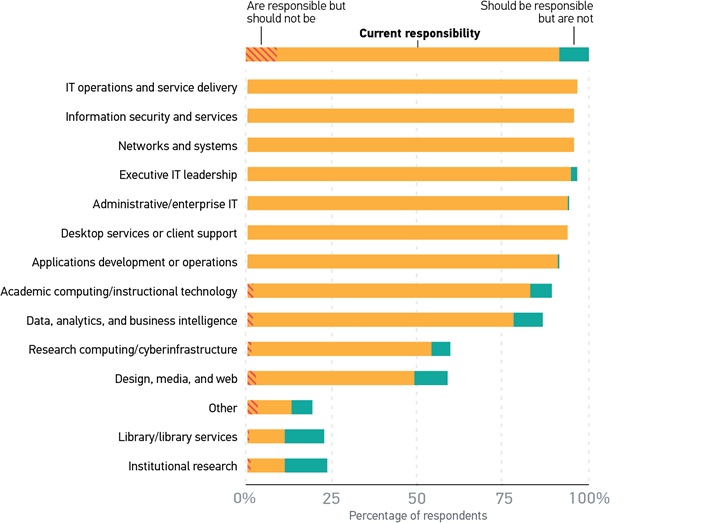The job of chief information officer (CIO) has a scope and influence across campus that makes it — according to some, anyway — the best job on campus. Not everyone aspires to the CIO role, however, considering the time, attention, and tolerance for uncertainty required by that level of leadership. Some have argued for eliminating the CIO role entirely and folding its responsibilities into other C-level positions. Yet research has shown that the CIO role is more prevalent and more important in higher education than ever.
Data collected by the EDUCAUSE Core Data Service show that 68 percent of institutions of higher education have a position titled CIO; the highest-ranking IT officer at the remainder of institutions may have a different title but performs similar functions. This ubiquity makes it critical for us to understand the nature and scope of the CIO role.
Respondents to the recent EDUCAUSE Center for Analysis and Research (ECAR) survey of CIOs were asked a series of questions about their current responsibility at their institution, areas that they are but should not be responsible for, and areas that they are not but should be responsible for. Figure 1 shows the responses to these questions.

Figure 1. CIOs’ current and ideal scope of responsibility
The big takeaway from figure 1 is that CIOs have responsibility for almost all areas of IT on campus. Furthermore, many CIOs believe that they should be responsible for more areas than they currently are. However, when we slice our findings by the Carnegie type and size of institutions, we find that the scope of CIOs’ responsibility is remarkably consistent across institutions — largely because they have responsibility for nearly everything.This has important implications for those who aspire to be CIOs: if this is you, recognize that you must gain experience in as broad a range of areas of IT as possible. It is therefore incumbent on you, as an aspirational CIO, to actively seek out these opportunities, particularly in areas in which you have little prior experience. Also recognize, however, that this takes time: current CIOs have worked in higher ed for a median of 18 years.
These findings reflect the state of CIOs in higher ed in general. It may or may not make sense for any individual CIO to have responsibility for nearly every area of IT on campus. Certain areas of IT lie outside of the IT organization on many campuses, and therefore outside of the CIO’s scope of responsibility: institutional research and libraries, for example. This is not universally true: both of these areas sometimes fall under the IT organization’s umbrella at some institutions. CIOs must consider the appropriate scope of responsibility for their position. This naturally depends on many factors, including the size of the IT unit at the institution and the strategic vision of the role of the IT unit at the institution. This is not a decision that the CIO can make unilaterally, however; it must be made in consultation with the CIO’s supervisor and other campus leadership. CIOs have a great deal of direct and indirect influence on campus-wide technology decisions. While the scope of the CIO role goes well beyond technology, the CIO influences technology decisions perhaps more than any other single position on campus. It is therefore incumbent on CIOs to develop a vision for the future of the role.
For More Information
For more on the role of the CIO in higher education, read the ECAR report IT Leadership in Higher Education, 2016: The Chief Information Officer, the first of four leadership reports in the EDUCAUSE IT Workforce in Higher Education, 2016, research series. Reports on the chief information security officer, enterprise architect, and chief data officer will be published later in 2017.
This IT workforce research and all ECAR publications will be available to individuals at EDUCAUSE member organizations beginning July 1, 2017, under the new, all-in-one membership.
Jeffrey Pomerantz is a senior research analyst at EDUCAUSE.
© 2017 Jeffrey Pomerantz. The text of this blog is licensed under Creative Commons BY-ND 4.0.
